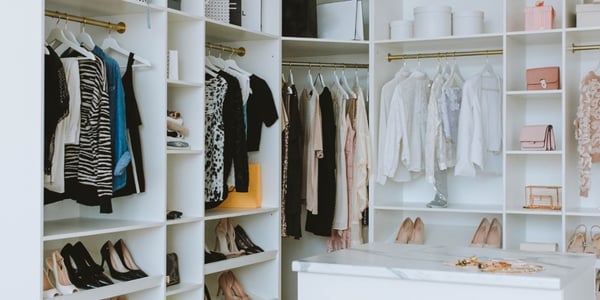Holding onto sentimental items is a common human experience. Whether it's a stack of old letters, a...


Holding onto sentimental items is a common human experience. Whether it's a stack of old letters, a...

For many homeowners, the idea of downsizing can be both exciting and daunting. Downsizing your home...

Whether you're moving out into a smaller place or if your kids have flown the nest, choosing to...

You are likely familiar with the old saying, "messy closet, messy life." This adage implies that...
From Cluttered to Clean: Organizing Tips for Downsizing Seniors
As we age, many of us find ourselves surrounded by decades of accumulated belongings. Downsizing can be both a practical necessity and an emotional journey. Whether moving to a smaller home, transitioning to assisted living, or simply wanting to create a more manageable living space, downsizing offers a fresh start and the opportunity to focus on what truly matters. In this blog, we’ll suggest some practical and compassionate organizing tips to help seniors easily navigate the process of downsizing.
Start Early and Plan Ahead
Downsizing is not something that should be rushed. Starting to declutter early allows for a more thoughtful and less stressful experience. Begin by setting a timeline with specific goals. Breaking down the process into manageable steps can make it less overwhelming. For example:
Month 1: Sort through closets and storage areas
Month 2: Focus on the kitchen and dining areas
Month 3: Tackle living spaces and bedrooms
Having a clear plan helps keep the process on track and provides a sense of accomplishment as each milestone is reached.
Set Realistic Expectations
Understand that downsizing is a process that takes time. Setting realistic expectations can help prevent feelings of frustration or being overwhelmed. Celebrate small achievements and recognize that every step taken is progress towards a more organized and manageable living space.
Sort and Categorize Belongings
The first step in the downsizing process is sorting and categorizing belongings. This can be broken down into three main categories: keep, donate, and discard. To make this process easier, consider the following tips:
Use the Four-Box Method
Label four boxes as "Keep," "Donate," "Sell," and "Trash." This method helps in making quick decisions and prevents the need to handle items multiple times.
Ask the Right Questions
When deciding what to keep, ask yourself questions like, "When was the last time I used this?" and "Does this item bring me joy or serve a purpose?"
Take it One Room at a Time
Focus on one area before moving on to the next. This prevents feeling overwhelmed and ensures that each space is thoroughly sorted.
Preserve Memories Without Clutter
Seniors often have a lifetime of memories tied to their possessions. It's important to honor these memories while still achieving a more organized home. Here are some ways to preserve memories without holding onto every item:
Create a Memory Box
Select a small box for cherished items that hold significant sentimental value. This allows for the preservation of memories without overwhelming the living space.
Digitize Photos and Documents
Scanning photos and important documents can reduce physical clutter while preserving these memories.
Pass on Heirlooms
Give meaningful items to family members or friends who will appreciate and use them. This can be a wonderful way to share memories and keep them alive.
Consider the Size of the New Space
When downsizing, it’s crucial to keep the size of the new living space in mind. Take measurements and create a floor plan if possible. This will help determine what furniture and larger items can realistically fit. Tips for adjusting to a smaller space include:
Opt for Multifunctional Furniture
Pieces like sofa beds, storage ottomans, and drop-leaf tables can save space and provide additional functionality.
Maximize Vertical Space
Use shelves, wall-mounted cabinets, and hooks to keep items off the floor and organized.
Keep it Simple
Choose furniture and decor that complement a smaller space rather than overcrowding it. Less is often more when it comes to downsizing.
Get Help When Needed
Downsizing can be physically and emotionally taxing, especially for seniors. Don’t hesitate to seek help from family, friends, or professionals. Here are some options:
Hire a Professional Organizer
These experts can provide valuable guidance and hands-on help to smooth the downsizing process.
Enlist Family and Friends
Loved ones can offer emotional support and practical assistance. They may also appreciate the opportunity to spend time together and share stories about cherished items.
Use Local Resources
Many communities have resources specifically for seniors, such as volunteer groups that assist with downsizing and moving.
Sell or Donate Unwanted Items
Once you’ve sorted through your belongings, it’s time to find new homes for the items you no longer need. Selling or donating unwanted items can be both financially beneficial and emotionally rewarding. Here’s how to go about it:
Host a Garage Sale
This is a great way to earn extra money while ensuring that items go to people who will use them.
Use Online Marketplaces
Websites like eBay, Craigslist, and Facebook Marketplace can help you reach a larger audience.
Donate to Charity
Many organizations, such as Goodwill, Salvation Army, and local shelters, will accept gently used items. Some even offer pick-up services for larger donations.
Recycle or Responsibly Dispose of Items
For items that can’t be sold or donated, ensure they are recycled or disposed of properly to minimize environmental impact.
Consider Renting a Storage Unit
When downsizing, renting a storage unit can offer a practical solution for items you’re not ready to part with but can’t fit into your new home. Here’s why a storage unit might be a good option:
Temporary Holding Space
Sometimes, it’s hard to make quick decisions about certain items. A storage unit provides temporary space for belongings you're unsure about. This way, you can take your time to decide without cluttering your new home.
Seasonal and Bulky Items
Storage units are perfect for seasonal items like holiday decorations, or bulky items such as lawn equipment, which you don’t need access to year-round.
Smooth the Transition
Moving can be hectic, and having a storage unit can ease the pressure. It allows you to move in stages rather than all at once, making the process less stressful.
Family Heirlooms
If you have items that are valuable to your family but don't fit in your new space, a storage unit can keep them safe until you decide on a more permanent solution.
Stay Positive and Focus on the Benefits
Downsizing can be an emotional journey, but it’s helpful to stay positive and focus on the benefits. A more organized and clutter-free home can lead to increased safety, reduced stress, and a greater sense of peace. Here are some benefits to keep in mind:
Simplified Living
Fewer belongings mean less cleaning and maintenance, allowing more time to enjoy hobbies and activities.
Enhanced Mobility
A clutter-free home is easier to navigate, reducing the risk of falls and accidents.
Financial Savings
A smaller living space often means lower utility bills, property taxes, and maintenance costs.
Create a New Routine
After downsizing, it’s essential to establish a new routine to maintain an organized and clutter-free home. Here are some tips to help seniors adjust to their new living environment:
Develop Daily Habits
Simple daily tasks like making the bed, putting items back in their designated places, and quickly tidying up can prevent clutter from accumulating.
Schedule Regular Decluttering Sessions
Set aside time every few months to reassess belongings and ensure the home remains organized.
Stay Mindful of New Acquisitions
Be thoughtful about bringing new items into the home. Adopt a "one in, one out" policy to keep clutter at bay.
Stay Emotionally Resilient
Downsizing can be emotionally challenging, especially for seniors with strong attachments to their belongings. Recognizing and addressing these emotions is crucial for a smoother transition. Here are some strategies to help maintain emotional resilience during the downsizing journey:
Embrace Change
Downsizing is a significant change, but it can also be an excellent opportunity for seniors to embrace a new chapter in their lives. By letting go of unnecessary belongings and focusing on what truly matters, seniors can create a comfortable, safe living space that reflects their current needs and lifestyle.
Create a Vision for the Future
Having a clear vision for your future living space can provide motivation and direction. Envision how you want your new home to look and feel. Focus on creating a comfortable, functional, and welcoming environment that aligns with your current lifestyle and needs. This vision can serve as a guiding principle throughout the downsizing process.
Take Breaks and Practice Self-Care
Downsizing can be physically and emotionally exhausting. Make sure to take regular breaks and engage in self-care activities that help you relax and recharge. Whether going for a walk, reading a book, or spending time with loved ones, taking care of your well-being is essential.
Celebrate the Journey
Finally, it’s important to celebrate the journey of downsizing. It’s not just about getting rid of things; it’s about creating a home that better suits the current stage of life. Take time to appreciate the progress made and the benefits of a more organized and clutter-free space.
The goal is to create a space that brings joy, comfort, and peace of mind. With these organizing tips, downsizing can be a rewarding experience that opens the door to new possibilities and a more fulfilling way of living.
Click here or the button below to apply for a TopLine Financial Credit Union mortgage today!
Living50+